
GLENN LONEY'S SHOW NOTES
By Glenn Loney, January 7, 2002

| |
|
Caricature of Glenn Loney by Sam Norkin. |
|
[01] "Queen of Spades" Siberia/Nuremberg Co-Production
[02] Nuremberg "Meistersingers" at the Met
[03] Nuremberg's "Christkindlmarkt"
[04] Nuremberg's Neue Museum Modern Art & Architecture
[05] New Propaganda Museum at Nazi Rally Grounds
[06] Bavarian Winter
Excursions: Bayreuth & Landshut
[07] In Ibsen's Footsteps in Berchtesgaden
[08] Ludwig's Castles in the Snow
[09] "Silent Night" in Salzburg & Oberndorf
[10] Winter Holidays in Munich
[11] Marvelous Christmas Creches
[12] Munich's Post-Modernist "Queen of Spades"
[13] Art Deco Operetta: "Vetter aus Dingsda"
[14] Dieter Dorn's New Look at Shylock & Antonio
You can use your browser's "find" function to skip to articles on any of these topics instead of scrolling down. Click the "FIND" button or drop down the "EDIT" menu and choose "FIND."
How to contact Glenn Loney: Please email invitations and personal correspondences to Mr. Loney via Editor, New York Theatre Wire. Do not send faxes regarding such matters to The Everett Collection, which is only responsible for making Loney's INFOTOGRAPHY photo-images available for commercial and editorial uses.
How to purchase rights to photos by Glenn Loney: For editorial and commercial uses of the Glenn Loney INFOTOGRAPHY/ArtsArchive of international photo-images, contact THE EVERETT COLLECTION, 104 West 27th Street, NYC 10010. Phone: 212-255-8610/FAX: 212-255-8612.
Siberia's Queen of Spades,
Nuremberg's Christkindlmarkt,
Neu Schwanstein's Blizzard,
Salzburg's New York Charity Concert,
And Other Winter Holiday Treats [*****]
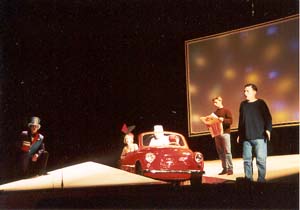 |
|
UPDATING TCHAIKOVSKY--Siberia/Nuremberg co-production of "Queen of Spades/Pique Dame," complete with sports-car! Photo: ©André Meyer 2001. |
From Siberia, With Love!
"You mean there's actually an opera-house in Siberia?"When I told colleagues I'd been invited to Nuremberg to see a Siberian/German co-production of Tchaikovsky's Queen of Spades, this was the typical response.
What American opera-lovers know about Siberia—which isn't much—is that it's where doomed heroines end up. If they don't die along the way into frozen exile…
In fact, there are eleven theatres in the regional capital of Kuzbass, where this interesting tour-ready staging was premiered last summer. The Culture-Minister, Vladimir Bedin—who accompanied the talented troupe of young Siberian singers—assured me I would be astonished at the depth and breadth of cultural activity there.
I fully intend to take him up on his invitation to come and see for myself. I'd also like to take a trip on the Trans-Siberian Railway, which has long been a dream of mine.
Anyone who has ever visited Moscow or Leningrad—now again St. Petersburg—knows how important culture in all its forms—especially Performing Arts—has been for the Russian People.
But under the Soviets—even beyond the Urals—every city and town of any stature had at least one theatre. In Perm, for instance, there is a ballet ensemble that has toured Western Europe!
In fact, it could be said—during the long tenure of the Soviets—that Russian Culture was a not-so-secret weapon against the crass, commercial, capitalist West. "Ny kulturny" was the Soviet dismissal of the Decadent West. No Culture!
Minister Bedin noted—with justifiable pride—that talented young Siberians receive absolutely free education and training in the performing arts. With so many theatres, it's obviously necessary to keep renewing their ensembles.
This investment, however, benefits a much wider public. Among the Siberian talents now well-known in the West are opera-star Dmitri Hvorovstovsky and violinist Maxim Vengerov. Recently, I had the opportunity to chat with Vengerov at the Salzburg Festival. He is an intelligent and charming young man, as well as a brilliant soloist.
The Pique Dame/Queen of Spades was not the only Siberian event in Nuremberg, however. It was the centerpiece of a two-week festival titled Unknown Siberia. So it's not only Americans who don't know much about Siberia! Germans are also becoming better informed…
In addition to a musical Siberian Christmas, Nikita Michalkov's film The Barber of Siberia, and a vocal excursion With the Trans-Siberian Railroad To Lake Baikal, the program included a Benefit Concert for the Children of Kemerovo.
This unusual event raised money for a desperately-needed X-ray machine for the Children's Hospital in Kemerovo. It included tasty Siberian foods and drinks, but its most important feature was showcasing the talents of the Pique Dame ensemble.
They not only sing in excellent Russian, but also in French, Italian, and German! They are prepared for international stages. In fact, the engaging baritone Oleg Malikov—who sang & acted Figaro's Largo al Factotum—is already performing in German opera-houses! He was impressive as Prince Jeletsky.
This Queen of Spades production has been directed by Peter Beat Wyrsch, founder and prime-mover of Nuremberg's excitingly avant-garde Pocket Opera Company. Wyrsch & Co. once managed the condense Wagner's entire 16-hour-long Ring into a matter of minutes!
Dr. Wyrsch's talents as a director—as well as an intrepid innovator in site-specific opera-productions—has been frequently noted in the German press. With the result that he is now Oberspielleiter—or Chief Stage-Director—of the Opera Münster. Not to be confused with the Opera Monster…
With a cast of only seven—one of them an actor, playing the poet Pushkin—and no chorus or ballet, the Kuzbass/Nuremberg version had to be both less lavish and less lengthy than Queen of Spades in a major opera-house.
The solution devised by Wyrsch and Music Director David Seaman—a mainstay of the Pocket Opera—was to omit all large-scale ensembles and concentrate on the high points of this intriguing music-drama. Actor Carlos Gundermann, as Pushkin, provided a narration which linked the major moments.
The Siberian/German production-team decided to update the story, setting it in contemporary Kemerovo. Hence the benefit tie-in with the X-ray machine.
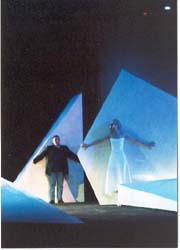 |
| RIVER NEVA ICE-BLOCKS--Abandoned by Hermann, Lisa prepares to jump to her death in freezing waters. Photo: ©André Meyer 2001. |
Video-footage of Kemerovo scenes were projected on a screen upstage of a set of inclined stark white platforms. In repose, they formed a slanted rectangle, but they could easily be shifted around in other conformations. Including the dark cold Neva River—into which the heart-broken Lisa was to disappear forever.
The entire cast was admirable. And—with the exception of the Countess, mezzo Janette Tarajahn—they all seemed in the bloom of youth. Excellent—in addition to Oleg Malikov—were Elina Alexandrova as the doomed Lisa, Elena Semikova as Pauline, and Vjatscheslav Schtyps as Count Tomsky. Think of that name Up In Lights!
As the desperate Hermann—who lusts for the secret of the three winning cards—Konstantin Golubiatnikov was dynamic both as singer and actor. That he was shorter than his colleagues in no way diminished his power as a performer. After all, Richard Tucker was no giant either…
Historical Footnote: After the Nuremberg performances, this pocket-opera production of Pique Dame was toured to the Stadttheater Landsberg am Lech. Landsberg may not be as well-known as Nuremberg or Salzburg, but it is notable for at least one thing. In its prison, Adolf Hitler wrote Mein Kampf.
Echt Nürnberger Lebkuchen
Und Weihnachts Christkindlmarkt!
Praeludium at the Met:
 |
| NUREMBERG
CROWD-SCENE AT THE MET--Historic Towers loom over "Meistersinger"
Masses Photo: ©Winnie Klotz 2001. |
[Years ago, when I was a press-ticket regular at the Met, I introduced her to the Press Officer so she might have the press-privilege on her regular visits to New York. Now, the Met doesn't welcome website reviewers—if it's not in print, it doesn't exist—so my dear friend, Erna Metdepennighen, kindly takes me with her! How's that for a really Flemish Name?]
Although I have long admired the stage-designs of Günther Schneider-Siemssen—and have written about his work in Theatre Crafts, New Theatre Quarterly, Western European Stages, and other journals—his Met Opera vision of the hometown of Albrecht Dürer pales beside the Real Thing.
And the current evocation of that famous medieval Song Contest for the hand and heart of Mastersinger Veit Pogner's daughter—talk about the Taliban's treatment of women!—was also less than wonderful.
When Ben Heppner—as a seriously overweight Walther von Stolzing—initially approached the female contest-prize after services in the Mastersingers' church, he looked more like Sir John Falstaff courting Mistress Ford in Verdi's remarkable comic-opera.
But the lovely young Eva—a radiant Karita Mattila—was wonderful. Not at all a mature married Mrs. Ford, fending off an obese admirer.
Unfortunately, Heppner's voice began to fade in the Schüsterstübe scene, so winning Eva with his Prize Song on the Festwiese was almost a consolation prize—because the rendition of his rival, Sixtus Beckmesser, was so horrendous.
 |
| GOLDEN ANGELS FLY OVER NUREMBERG'S CHRISTKINDLMARKT. Photo: ©Glenn Loney 2002. |
The Historic Nuremberg Christ-Child Market—
An added impetus to make the holiday trip to Bavaria was to visit the famous Nuremberg Christkindlmarkt. This tradition stretches back into medieval times. But not just in Nuremberg…In the days immediately before Advent, inviting booths and stalls are set up in the great square dominated by the Schönen Brünnen, a glittering gold-leafed gothic fountain, with images of Biblical notables and famous Kings.
Colorful hand-blown glass tree-ornaments glow in the lantern-light. Stars of the East, woven from straw, hang above hand-carved, hand-painted wooden toys and dolls.
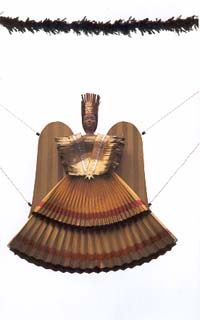 |
| THE EASTERN STAR WOVEN OF STRAW. Photo: ©Glenn Loney 2002. |
Nuremberg is world-famous for its Lebkuchen—a very special kind of very durable gingerbread—so stalls are crammed with cookies and even sugar-coated hearts of gingerbread. Not to overlook the dark brown loaves of Fruit-Bread!
Deep in the heart of Southern Saxony—in such quaint towns as Annaberg/Buchholz—whole families are still carving Christmas Panoramas, Nativity Scenes, and Windmills as they have done for centuries. Noah's Arks are a specialty.
Some of the finest of these were on sale in Nuremberg. But this kind & quality of handwork doesn't come cheap anymore. So it was no surprise to discover—behind some toy-booths with fire-sale prices—empty boxes stamped Made in China!
At least the Lebkuchen are not made in China. Yet…
Advent booths ran all the way up the hill to the medieval St. Sebaldus Church, where Nuremberg's suburbs offered their wares and mugs of spiced warm Glühwein.
The only problem seems to be that the Christkindlmarkt has become such a worldwide tourist-attraction that one can hardly move in the corridors between rows of booths. Let alone buy or photograph the beautiful toys, ornaments, and sweets.
Italian, French, and Spanish holiday-makers were everywhere. And, of course, platoons of photo-snapping Japanese. If Japan is in a Major Recession, its hordes of travelers abroad don't seem to know about it yet.
In the square before the Heilig-Geist- Spittal—wonderful Bavarian cooking in its historic restaurant!—was a handsomely carved and decorated carrousel. And more booths and rides, as this is the traditional Children's Christmas Market.
Near the Hauptbahnhof and the formidable Stadtmauer—or great city-walls—more booths and stalls strung down the broad main street to the venerable St. Lawrence Church. It is famed for its immense polychromed wooden rosary, hanging above the High Altar, carved by Veit Stoss. [Who had a nail driven through his gifted hand in Cracow centuries ago. Talk about Cruel & Unusual Punishments!]
And you can see the self-portrait in stone of sculptor Adam Kraft, in his great gothic masterwork beside the High Altar of the Laurentiuskirche.
I didn't get to see The Mastersingers of Nuremberg in Nuremberg's immense Jugendstil Opera-House because they were playing Wagner's Die Walküre instead. Not exactly a Holiday Opera…
But, in addition to Pique Dame from Siberia, I also heard Handel's Messiah in St. Lawrence.
New Museums & New Exhibitions in Nuremberg—
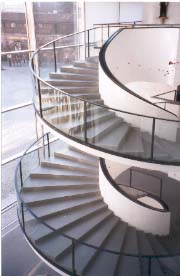 |
| ROUND AND ROUND--Nuremberg's Post-Modernist Neue Museum. Photo: ©Glenn Loney 2002. |
One of the most impressive recent additions is its Neue Museum, a triumph of Post-Modernist architectural ingenuity. Glimpsed from an ancient street, crowded with historic facades, it seems little more than a strangely curved glass slot in the redstone building-fronts.
This narrow alleyway, however, opens onto an enclosed plaza, near the old city walls. Here, the Museum's front is a vast expanse of curved glass, with a wonderfully sinuous spiral staircase dominating the interior. Its holdings in Modern Art are colorful and representative. Many of the usual American and European Suspects are on view.
In the handsome new Post-Modernist extension of the German National Museum—where the Kemerovo benefit concert was held—a splendid exhibition of artworks created in major European Artists' Colonies is currently on view.
Some of the more impressive canvases have been seen in New York in other exhibition-contexts, notably in Northern Light, Scandinavian paintings at the Brooklyn Museum. [Or was it at the Met?]
This is a carefully-curated show—with a copiously illustrated catalogue. If the exhibition does not travel—as it obviously ought—to major American museums, at least this splendid volume should be made available in translation.
The show includes ceramics and other objects d'art, as well as paintings and drawings. Fine examples are included from the Mathildenhöhe Künstler Kolonie in Hesse-Darmstadt—which still sends me invitations to its own musem shows.
I was puzzled that nothing from Dresden's famed Hellerau Colony was on view. But I was then reminded that Hellerau was concerned with dance, music, and stage-design, not with painting and sculpture. Movement & Dance Master Jacques Dalcroze and Swiss designer Adolph Appia were stars at Hellerau.
But until the Fall of the Berlin Wall in November 1989, one could not pass beyond the high concrete walls surrounding Hellerau. It was a Soviet Kaserne. And the departing Russian soldiers left the handsome Art Deco buildings almost in ruins.
How Did the Nazis Use Propaganda To Come To Power?
A rather different museum-experience has just been inaugurated in Nuremberg's suburban Stadtpark. After 1933, however, this huge area was the Parade Grounds of the Nazi Party, shown in impressive but frightening detail in action in Leni Riefensthal's quasi-documentary, The Triumph of the Will.Hitler's favorite architect, Dr. Albert Speer—who designed the great searchlight/torchlight parade spectaculars for the annual NSDAP Party Rallies—was drafted to design a major complex to celebrate the might and majesty of the Third Reich. Which was supposed to endure for a Thousand Years!
The Great Tribune was completed early in the life of what turned out to be only a Twelve-Year Reich. Its huge stone Swastika was dynamited in 1945, by American troops. And its great long colonnade of squared columns was demolished in 1968, by the City of Nuremberg, as structurally unsound.
What was to have been the Largest Stadium in the World—dwarfing Rome's Colosseum—was hardly begun. Its huge slave-labor-quarried stones are now overgrown with trees and shrubs. Its foundation cavity became a brackish lake, even in World War II, when all work had to cease.
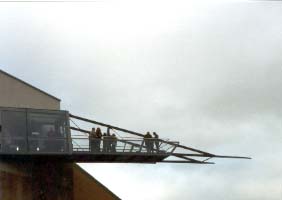 |
| PIERCING NAZI PROPAGANDA--Lance-like shaft through Nazi Congress Hall, now NSDAP Documentation Center. Photo: ©Glenn Loney 2002. |
The immense Congress Hall—also never finished, but roughed out like a huge Horseshoe, or half a Colosseum—still stands. It is too big and too solid to demolish. But its mammoth proportions don't make it easily adaptable for offices or condos.
It has been used for storage of scenery and costumes from the city theatres. But it was always closed to the public.
Now a section of the horseshoe has been pierced by a Post-Modernist lance-like entrance-shaft which runs through its core to soar up and out over the open courtyard inside the great U.
Interior spaces have been adapted as video-theatres and exhibition-spaces to chart the Tyranny of Terror that Hitler and his henchmen unleashed on Nuremberg, Germany, and Europe.
Not only has this new museum provided a jolt to those who lived through the Rise of Hitler—some of whom may have never yet come to terms with what happened. But it is especially fascinating for young Germans, many of whom have no idea of how the Nazis could have seized power and attempted to conquer all Europe.
Although Berlin was Nazi Germany's Capital, and Munich was the Stadt der Bewegung—the City of the Movement, where it all began—Nuremberg was especially appealing to Hitler and his chief-propagandist, Dr. Joseph Goebbels.
Its former Free & Imperial status, its enchanting medieval architecture, and its long history of Germanic Culture—Albrecht Dürer & Hans Sachs lived and flourished here—made it specially significant for the Nazis.
But, given Hitler's huge appetite for gargantuan architectural projects, Nuremberg's historical treasures were in danger of being vastly overshadowed—even obliterated—by the Monumental Structures of the Nazi Reichsparteitagsgelände.
Hitler and Speer had also conspired to remake historic Bayreuth and Austrian Linz—close to the Führer's birthplace—as Monumental Nazi Shrines when Germany had won World War II.
Even the famously classic Weimar of Goethe & Schiller was partially transformed in the 1930s. Some of those imposing buildings can be seen today. In the equally dictatorial and monument-infatuated DDR period, they fit in just fine.
The various aspects of the newly installed exhibitons—very impressively and ingeniously designed—document the deft use of the then new propaganda methods to "sell" the Nazis to the German People.
And to rebuild German Pride, after the humiliations of the massive defeat in World War I and the perceived injustices of the Treaty of Versailles.
This new multimedia installation grew out of a fascinating prior exhibition—in the long hall under the Great Tribune—on the occasion of the 60th anniversary of the Nazi Seizure of Power, or Machtübernahme. This much smaller show was titled Faszination und Gewalt: Fascination and Force.
For such an exciting, provocative adventure in museum and exhibition design—and dealing with such an important segment of Life in the 20th Century—you might think the new facility would have an equally arresting name.
Unfortunately, this is currently not the case. Its official title is: Dokumentationszentrum Reichsparteitagsgelände!
That may well say it "all in a nutshell" for German museum-goers. But it's a baffling title for the hordes of foreign tourists now thronging the haunted chambers of the Nazi Congress Hall. But certainly it's Very Germanic!
Bavarian Winter Holiday Excursions—
It's only an hour to Richard Wagner's Bayreuth from Nuremberg on what used to be called the Pendelzug, as it shuttles back and forth. Bayreuth looked festive in the dying afternoon light—and it also had its own Weihnacht booths & stalls! There were no Wagner operas on view, however. One has to wait for the annual Festspiel in July/August.Historic Landshut was more subdued, especially with snow flurries and setting sun. But its amazing church—studded with medieval monuments—is still one of the wonders of Central Europe. It has the Tallest Brickwork Steeple in Europe. Possibly in the world…
Landshut is well worth a visit—not many know of it. Every three summers, the citizens, young & old, re-enact its most famous event in the Middle Ages: the Landshuter Hochzeit.
Princess Jadwiga of Poland came all the way from her native land in a Golden Coach. She married the son of Duke George the Rich of Bavaria. Being chosen as Jadwiga—also known as Edwige or Hedwig, but not of the Angry Inch—is the local equivalent of becoming Miss America.
The re-creation features the entry into the city of the great Gold Coach—more like a wagon—accompanied by Knights, Nobles, and Commoners in medieval costumes. It is quite a colorful Procession!
The wedding ceremonies are re-enacted, followed by performances, puppets, dances, & songs. There's even a Medieval Jousting Tournament—in heavy armor with real lances!
And, of course, Medieval Feasting, with slabs of beef, pork, and lamb, carved smoking-hot from the roasting carcasses. And plenty of mead and Bavarian beer!
In Ibsen's Footsteps in Berchtesgaden—
Henrik Ibsen—who preferred to write so damningly of Lutheran Norway and small-minded Norwegians from the safe distance of Munich, and even of Rome—summered in Berchtesgaden. I had to dust away drifts of snow and dead vines to find the plaque which, in effect, tells you: Ibsen Slept Here.It is, of course, also where Adolf Hitler and his Inner Court had their Alpine Retreat. A luxury hotel is now to be built on the site of Hitler's Headquarters here. The developers insist it will not become a Pilgrimage Site for Neo-Nazis. The prices will be too high. And they plan a Holocaust Museum, Documentation Center, or some similar sop to sentiment.
The shops were crammed with glittering ornaments, bright toys, and tasty candies & cookies. There were also many decorated trees, but down the steep mountainside on which the city is sited, the real live Tannenbaums, drooping in snowdrifts, looked much more Christmasy.
Neu Schwanstein & Hohen Schwangau in the Snow—
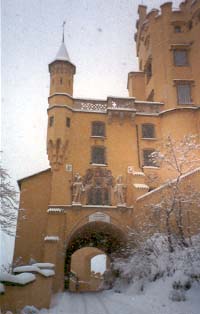 |
| KING LUDWIG'S CASTLE HOHEN SCHWANGAU IN SNOWSTORM. Photo: ©Glenn Loney 2002. |
Not to omit photos of Hohen Schwangau, the much older castle—on a lower mountain—in which the highly impressionable Ludwig had spent much of his lonely childhood.
It was 25° below zero, however, so my zoom lenses were already freezing when I was photographing the romantic summer villas and resort hotels at the feet of the two Castle-Mountains.
By the time I worked my way up the rear coach-road to Schwangau, the point & shoot Leica was focusing on the snowflakes, not the castle. Then it froze altogether. My excellent Nikon 8008 continued to function—though its metal case was very very cold. The snowfall had turned into a blizzard. Horse-coaches weren't going up the steep road below Neu Schwanstein. But there were still determined tourists making the climb!
The gusts of snowflakes were so thick, the photos show the castle's towers only as misty ghosts. Then I lost my footing, fell on my camera-bag, and slid down the mountain path like a human toboggan! Leica replaced my camera—for which many thanks!
Across Lake Forggen from the two castles, the Ludwig Musical Theatre—a handsome new evocation of Wagner's Bayreuth Festspielhaus—unfortunately wasn't at the moment performing its King Ludwig Musical, Dream of Paradise.
This is a fabulous show—at Broadway prices!—on which I reported in Entertainment Design, as well as on this site. Its attractive foyers, Ludwig-oriented displays, gift-shops, and restaurants were, however, open for business.
The theatre's creator & impressario, Stephen Barberino, and his architect-wife, Josephine—who designed the musical playhouse—have devised a remarkable tourist-attraction here. It complements the tourist-lures of the nearby historic town of Füssen. And of Passion Play Oberammergau, just over the mountains, so to speak…
Silent Night in Salzburg & Oberndorf—
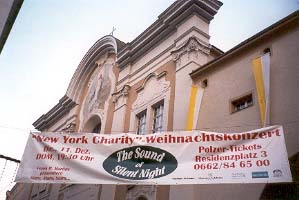 |
| NEW YORK CHARITY CHRISTMAS CONCERT IN SALZBURG. Photo: ©Glenn Loney 2002. |
Ms. Andrews has another performance-connection with Salzburg as well. She and the Von Trapp Family hid out in the catacombs of St. Peter's Abbey when the local Nazis were after them in the film of The Sound of Music.
Although it's known locally as Meine Lieder, Meine Träume—My Songs, My Dreams—the film has never been a big favorite in Salzburg. Except with American tourists, who cannot get enough of lunch-included tours to all the historic sites used in the Hollywood movie.
The biggest holiday attraction, however—among a glut of Mozart & Handel Christmas Concerts and Salzburg Marionette shows—was a one-night-only NEW YORK CITY CHARITY CONCERT. Even in the far distant Austrian Alps, people join with mourning New Yorkers, sharing their pain and loss!
This impressive concert was performed in the great baroque Cathedral, featuring such international stars as soprano Grace Bumbry. As well as Maximilian Schell and the Vienna Choirboys!
Bumbry was a memorable Lady Macbeth at the Salzburg Festival early in her career. I interviewed her at that time, and she told me she'd prepared for the dramatic aspects of the role by reading a work called Girlhoods of Shakespeare's Heroines. Well, why not?
The traditional Salzburger Advent—music & drama performed in the severely neo-classical baroque Jesuit Kollegienkirche—was also a not-to-be-missed but almost-sold-out experience.
 |
| SALZBURG HOLIDAY DECOR. Photo: ©Glenn Loney 2002. |
It was very cold in this immense cathedral-sized church, but I heard an English-language tour-guide explain why: "Catholic churches are so big they are very expensive to heat. Evangelical [Lutheran] churches, on the other hand, are small, so it is easier to heat them!"
There was a very crowded Christmas Market in the great square in front of the Cathedral. One could hardly get near the booths to see or to buy. But the crowding was much worse in Nuremberg… Near the baroque Mirabell Gardens—its urns and statues shrouded in snowdrifts—a smaller market was thriving.
As I do every summer in Salzburg, I stayed on the other side of the Salzach River from the historic Old Town. I was, in fact, almost across the street from the Silent Night Museum, presided over by Hanno Schilf.
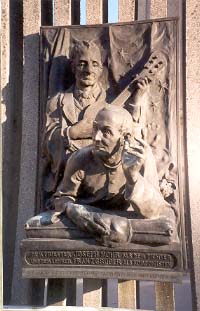 |
| CREATORS
OF "SILENT NIGHT"--Father Joseph Mohr & Franz Xaver Gruber.
Photo: ©Glenn Loney 2002. |
It is located in the house where Father Joseph Mohr—the creator of Silent Night—grew up. Schilf is something of an expert on Mohr and his beloved Christmas Hymn, now known the world over. He has written two books on this subject. One is titled simply Silent Night! Holy Night!
The family actually had only one cold, damp room in the medieval building. But Schilf has furnished a small suite of rooms on an upper floor with historic artifacts—to show how poor people lived so long ago.
He urged me to go to Oberndorf—site of theSilent Night Chapel—but he pointed out what few people know. Oberndorf is not the original site of the First Performance—although the locals are certain that it is.
Nor did Franz Xaver Gruber—credited with the song's melody—actually compose the tune. He only arranged it later for Mohr in Oberndorf. Mohr first played Silent Night in Mariapfarr! And he accompanied it on the guitar, an instrument frowned upon in Austrian Catholic churches in that age.
Hanno Schilf's relatives in Manhattan were great and early friends of Dr. Ruth Westheimer—TV's famed Dr. Ruth—so she and many other celebrities have made the Salzburg pilgrimage to the Silent Night Museum.
The Mohr Rooms are too small for large tours. Reservations are required. You can plan ahead, order Schilf's books, obtain a facsimile of the original song-manuscript, or just get more information by email or website:
www.silentnightmuseum.org
hanno@silentnightmuseum.org
The trip to Oberndorf by local train-service is fairly rapid, with scenes of Salzburger Land few tourists ever see. The imposing Parish Church has a Mohr/Gruber Memorial and some wonderful baroque saints and 19th century Stations of the Cross.
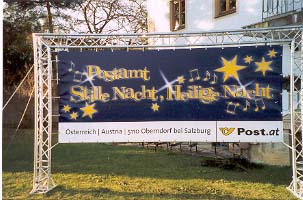 |
| AUSTRIAN OBERNDORF'S "SILENT NIGHT" POST-OFFICE. Photo: ©Glenn Loney 2002. |
But it's some distance from the actual Chapel and the Silent Night Post Office—which has its own special cancellation. There's also a Museum, a Medieval Water Tower, and a great bend in the Salzach River. Over which local uniformed River Traffic Guards kept watch on the ships and salt-laden barges in Salzburg's Era of Greatness.
The Chapel replaces the church in which Father Mohr and organist Gruber introduced the hymn to a wider audience than Mohr had in Mariapfarr.
I didn't have time to go to nearby Hallein—noted for its Salt Mines—to pay my respects at Father Mohr's gravesite in the parish churchyard. But I had already photographed it several times.
Protestant Note: For one raised on Martin Luther's Wiegenlied, or Cradle-Song, it may seem strange not to hear this also hallowed Christmas hymn celebrated in Bavaria and Salzburg. It is not only not widely or loudly sung; it's not much mentioned during Advent.
But then this area of Southern Germany is historically Roman Catholic. And Luther was a renegade monk who ran away with a nun. And who caused no end of trouble for the Pope, who would have burned him at the stake if Luther the Reformer had been so unwise as to come to Rome to plead his case.
But this area is a place where the Thirty Years War—between Catholics & Protestants and their feuding monarchs—is still not forgotten.
Winter Holidays in Munich—
Medieval Munich is evocatively recalled with its Christmas Market in the great square before the reconstructed Gothic Rathaus—which features a wonderful mechanical clock with the carved wooden Morris-Dancers of Erasmus Grasser.In late 1945—thanks to Allied Bombing Raids—this ancient city was 90 percent destroyed in its historic interior. So it's a wonder also that many of its most famous monuments were reconstructed so soon after World War II.
[Will the Afghanistanis be able to reconstruct those two monumental demolished Buddhas? At least we didn't destroy them; the Taliban did… We only bomb Enemies of America!]
After the merchandising excesses of Nuremberg, Munich's attractive booths and stalls were less thronged. But there were still some empty Made In China cartons in the nearby rubbish-cans.
Munich's great Neo-Classical National-Theater—the mainstage for its outstanding opera-productions—sits on a great square completely free of holiday stalls. But it stands majestically beside the Maximilianstrasse—like Madison Avenue or the Via Veneto—the showplace of all the major fashion-houses. All of which were extravagantly decorated for the holidays.
Behind the opera/drama complex facing Max-Joseph-Platz, a major construction project is underway. Since 1945, some war-damaged structures here have remained almost as deliberate reminders of the havoc wrought by the bombings.
Ostensibly, there wasn't money enough for this grand project until now. Maxstrasse facades will be preserved and/or reconstructed. New rehearsal facilities will be created in a great new glass-house behind them and next to the magnificent Marstall, or Royal Stables.
Marvelous Miniature Nativity Scenes—
Munich is not only famed for its architecture—with a number of imposing 19th century public buildings inspired by Renaissance Florence—but also for its many magnificent museums.
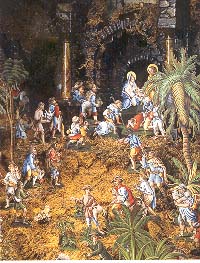 |
| MUNICH'S HISTORIC CRECHES--Fantastic details are hallmarks of master-craftsmanship. Photo: Courtesy of Bavarian National Museum. |
During Advent, however, the most interesting place to be is in the extensive collection of Christmas Creches in the Bavarian National Museum. A number of these were hand-crafted by Neapolitan artisans.
True, the Metropolitan Museum in Manhattan has a wonderful array of 18th century Angels and Nativity figures from Naples. But its lifelike artifacts—usually displayed on a great Christmas Tree in holiday season—cannot begin to compete with the many complete biblical scenes on display in Munich.
The Visit of the Holy Three Kings obviously offered Neapolitans—and Alpine wood-carvers as well—the opportunity to show their skills in creating lavish and detailed miniatures of the gifts of the Wise Men and the gorgeous trappings of their entourages.
These dioramas remind us, as well, that you don't get many Wise Men coming to Bethlehem these days. They are unfortunately in very short supply everywhere right now.
And Christian racists would do well to remember that one of these Magi was a Black King! Not to overlook the fact that Jesus' Mother was Jewish!
Not all these miniature Sacred Scenes concentrate on The Annunciation, The Nativity, or The Three Kings of Orient. The horrors of Herod's Massacre of the Holy Innocents held questionable attractions for Neapolitan, Swiss, and Bavarian artists as well.
Actually, the Munich Creches include wax-worked and wood-carved scenes from the early 19th century, as well as from the more pious 18th.
In Alpine Oberammergau—just a short rail-journey from Munich—you can still acquire beautifully carved wooden Nativity Scenes. Or Crucifixions, if those are more to your taste…
Another View of Pique Dame—
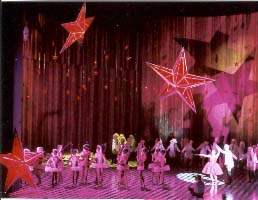 |
| TCHAIKOVSKY'S LAS VEGAS REVUE--Or Munich's "Queen of Spades." Photo: ©Wilfried Hösl 2001. |
I'd already studied fantastic production-photos of this innovative staging, but I had not actually seen it. Considering the ensembles, the budgets, the advanced technology, and the grandiosity of the Bavarian State Opera's stunning theatre, I realized there could be no real comparison with the much more modest mounting of Nuremberg/Siberia.
In one way, however, there was a parallel. Both were set in modern times. But Kemerovo is much less populous and impressive than the Post-Modernist Petersburg designed for the Nationaltheater.
Nor does Lisa drown herself in the Neva in Munich. The local river is the Isar, in any case! No, no! Not at all…
American-born director David Alden—famous or infamous for some quirkily updated or re-imagined Handelian operas in Munich—has Lisa smash a glass show-window. With the suitcase she'd brought for her elopement with the faithless Hermann.
In the window is a white wedding-dress, which Lisa might have worn if Hermann were not obsessed with the three cards: Three Seven, and Ace. She cuts her wrists—which is much simpler to stage than a leap into the Neva.
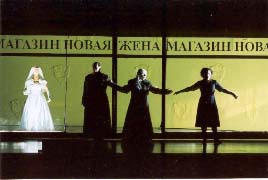 |
| NO WEDDING-GOWN FOR LISA--Ready for Suicide in "Queen of Spades." Photo: ©Wilfried Hösl 2001. |
In the event—as every opera-lover should know—instead of the Ace, the Queen of Spades confronts him. All Is Lost! And he has caused the Countess' death, in his fierce determination to learn her secret of winning at cards.
Paul Steinberg's colorful Memphis-inspired sets and Constance Hoffman's trendy costumes make this production look like Petersburg in Las Vegas. Showgirls and revue-dancers dazzle. Tchaikovsky would have been amazed.
But then, Petersburg is already in Las Vegas, with Treasures of the Hermitage Museum on display—in tandem with the Guggenheim Museum—at the Venetian!
Jun Märkl conducted and cued an outstanding cast. It included Robert Dean Smith—a big Bayreuth favorite—as a very handsome and obsessive Hermann, opposite Tatjana Monogarova as Lisa.
The imposing and affecting Rita Gorr was a magisterial countess, yet world-weary. Elena Zaremba was Polina—or Pauline.
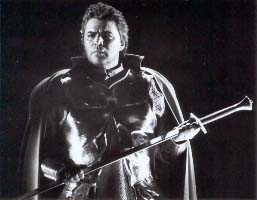 |
| PETER
SEIFFERT AS LOHENGRIN. Photo: ©Wilfried Hösl 2001. |
As a counterpoise to Queen of Spades—whose hero behaves so badly—I took a new look at the Bavarian State Opera's production of Lohengrin. The Swan Knight is nothing if not caring of the woman he loves. But she will be asking questions when he's told her not to…
This staging—by the late Götz Friedrich of the Deutsche Oper Berlin—is still problematic. But it seems to have been somewhat reworked from its Munich Festival premiere some summers ago.
I didn't like Andreas Reinhardt's sets then. And I still do not. Nor do I admire the curiously designed handling of the Swan Knight's initial appearance. It is still muddled and unimpressive.
But—as at the Bayreuth Festival last summer—Peter Seiffert is overwhelming as Lohengrin. He not only looks heroic—every inch—but he is a magnificent Heldentenor.
On this evening, Staatsintendant Sir Peter Jonas came forward to ask the audience's indulgence for Seiffert's potential vocal difficulties. They were almost undetectable. He gave a powerful performance, not wanting to disappoint with a cancellation.
He was matched by an evenly strong cast: Kurt Rydl as King Heinrich, newcomer Soile Isokoski as Elsa, and a powerful pair of plotters: Waltraud Meier and Sergei Leiferkus as Ortrud and Telramund.
Their very strong performances—and what may have been some re-staging—made this production at last very rewarding for me.
But I still don't like that huge tree-trunk with all those spears in it. Or are they supposed to be branches? Or what?
Andreas Reinhardt was a favorite designer of the late directorial-terror, Ruth Berghaus. Which could explain—or even excuse—much of his ill-advised design excesses.
Hello, Dolly! Missed by a Day!
When in Munich, I never miss an opportunity to see musicals, operettas, or even operas at the city's No. 2 opera-house, the Gärtnerplatztheater.Its operas are staged in muted competition with the Bavarian State Opera, but at lower prices. As with the London balance between the English National Opera and the Royal Opera, Covent Garden, this much smaller stage opts for inventive & innovative productions. With less well-known voices, but no less talented actor-singers.
I missed their premiere of a new staging of Jerry Herman's Hello, Dolly! by one day. Alas. They do Broadway musicals very well. Their recent West Side Story was exemplary. It could have been an American cast, with energy, looks, and passions to match.
 |
| FLAPPER FENDS OFF FORTUNE-HUNTER--Scene from Munich's "Vetter aus Dingsda." Photo: ©Johannes Seyerlein 2001. |
In the event, the production I was able to see was a charmingly Art Deco version of Eduard Künnneke's operetta, Der Vetter aus Dingsda. A Vetter is a cousin or relative. Dingsda is not a real location: it's a dismissive "that place there" somewhere/nowhere.
The lovely and rich young heiress Julia loves only her cousin Roderick, who went out to Batavia [Java] to make his fortune seven years ago. So long she's forgotten what he looks like…
But her greedy guardians, the Kuhbrots [CowBread], want to keep her fortune in the family, by marrying her off to their clueless nephew, Egon von Wildenhagen.
His suit is useless—and the one he's wearing also looks unpressed—for Julia wants only her long lost Rod. A handsome young man opportunely turns up—but is he the Real Rod? Perhaps not, but then a second stranger appears on the scene!
Designer Pantelis Dessyllas' wonderful Jugendstil Villa—with front walls that slide round to open and shut—is a brilliant invention which serves the production very well. As do the Jazz Age costumes of Sophia Schröck. This production dates back to 1992.
Way back in 1970, I interviewed this talented design duo when they were doing some magical things in Vienna at the Staatsoper!
Andreas Puhani conducted with brio. The attractive cast included Gabriela Bone as Julia's confidante. Heroine Julia was Hlín Pétursdóttir—whose name indicates her Icelandic birthplace.
Fritz Graas and Gisela Ehrensperger were the comic-opera self-important guardians. Peter Petrov and Frederic Mayer were a pair of dead-pan butlers, hardened to almost any nonsense in the Kuhbrot Villa.
Florian Simson had the difficult task of playing an unlovable wimp, with lucky Michael Gann and Gunter Sonneson the attractive strangers. One of whom might be Julia's Rod…
The score is pleasant enough—not quite vintage Noël Coward—but with a Twenties Flavor. Nonetheless, don't wait for a revival Off-Broadway. By Jeeves has just about killed off that period, even in an Andrew Lloyd Webber pastiche…
The same day I saw Der Vetter, I found a report in the Frankfurter Allgemeine that the Octogenarian Intendant of the Bayreuth Festival, Wolfgang Wagner, had just welcomed a new colleague to aid him with fund-raising and economic problems facing this venerable annual Wagner celebration.
He is none other than Dr. Klaus Schultz, Staatsintendant of the Gärtnerplatztheater!
The Culture Mavens of the Bavarian State have been worried about a successor for the aging Wolfgang Wagner—who has a lifetime contract and who shows no signs of retiring—so Dr. Schultz must be a very welcome solution to some of the current problems between Munich and Bayreuth.
Wagner wants his wife Gudrun and his daughter Katherine to succeed him. The Bavarian State recently opted for his estranged daughter by his first marriage, Eva Wagner-Pasquier. But she graciously has stepped aside, in deference to her father.
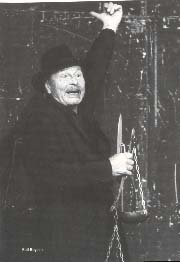 |
| Rolf Boyden as Shylock |
Dieter Dorn Studies the Shylock Paradox—
The hot-ticket in Munich's drama theatres was for Dieter Dorn's Der Kaufmann von Venedig, starkly staged at the Residenz Staatstheater.Dorn had previously created impressive stagings as Intendant at Munich's Jugendstil city-theatre, the Kammerspiele. His staging of Botho Strauss's Ithaka was magisterial.
At last, he has been rewarded with the leadership of Bavaria's premiere drama theatre, bringing with him outstanding actors from his former ensemble.
Dorn has also distinguished himself at Bayreuth, with a memorable Der fliegende Holländer. And with a recent debut at the Met in New York, staging Tristan und Isolde. As in his most powerful drama productions, his directorial work on both opera-stages was greatly assisted by the ingenious designs of Jürgen Rose.
Their masterstroke in the Liebestod of the Met's Tristan—with Ben Heppner and Jane Eaglen as the two seriously hefty lovers—was to have them sing the LoveDeath duet in silhouette! They have the voices, but not the slim trim figures of heroic young lovers.
Difficult as Shakespeare's Merchant of Venice is to produce anywhere—Tel Aviv, Cairo, Kabul?—the drama has a special negative resonance in Germany and Austria. But Shylock is a role major actors cannot ignore…
Nor can the drama be ignored. It is part of the Canon, after all. Dorn's solution is to cast both Shylock and Antonio with two very powerful, seasoned, and widely admired mature actors: Rolf Boysen and Thomas Holtzmann.
Nor has Dorn made Shylock a simplistically unrelenting villain, a passionate hater of Christians, an implacable enemy, only seeking revenge in the death of his major antagonist. He is much more complex than that, after all.
After 9/11, it might even become trendy to present Shylock as a Renaissance version of Osama bin Ladin. Someone is sure to try this soon…
Fortunately, Dieter Dorn did not have this model in mind when he was preparing this bare-bones production. Instead, he was seeing Antonio and Shylock as two sides of the same commercial coin.
Brothers, in a sense. One an entrepreneur—risking all on far-off voyages. The other a money-lender—but not a loan-shark—risking all on the return of those caravels.
Thus, in Dorn's Kaufmann, they are dressed alike in sober black. And, indeed, they are much of a speculative match in dark, dour dispositions. They seem always worried, thinking, planning. Even scheming…
And at the close of the drama—after the wonderful Sibylle Canonica's Portia has evoked the Quality of Mercy—Shylock is chastened but still in business.
He and Antonio blackly, broodingly confront each other across the broad bare stage. Life—and Commerce—continue in Venice. Even if his once beloved daughter Jessica is now a Christian, experiencing the uneasy courtesies of those Christian-born, not converted.
Considering the withdrawn, skeptical Antonio Holtzmann plays, it is even more difficult to understand why he would risk so much of his capital for Bassanio, a lightweight mayfly lover, in search of a woman with a fortune.
This seems neither the attachment of an older childless man, looking for a son. Nor the more obvious latent homosexual attraction so popular in recent productions.
The Residenz's bare splintery stage is dominated by a big black cube center-stage. When it opens out its panels, it becomes Portia's neo-classic villa at Belmont.
This is yet another of designer Jürgen Rose's brilliant strokes. His costumes also managed wittily to suggest both Now and Then. Bassanio's chums and Antonio's colleagues behave a bit like Mafia comics. Kiss Me, Kate and Brush Up on Shakespeare came immediately to mind…
This was not exactly a Christmas Pageant—and certainly not a Purimspel—but it provided a needed note of seriousness in a season when both Europeans and Americans need to understand more about age-old religious prejudices and hatreds. And not only in Venice. Or in Munich…[Loney]
Copyright © Glenn Loney 2002. No re-publication or broadcast use without proper credit of authorship. Suggested credit line: "Glenn Loney, New York Theatre Wire." Reproduction rights please contact: jslaff@nytheatre-wire.com.
| museums | recordings | coupons | publications | classified |